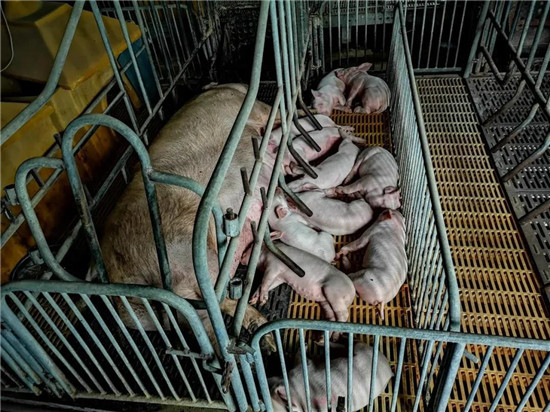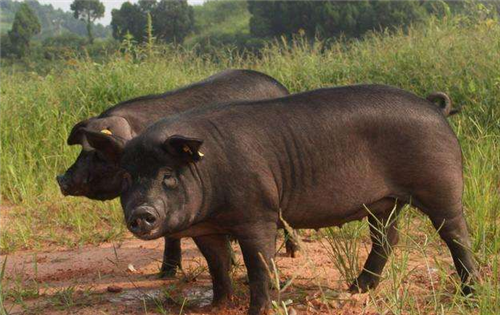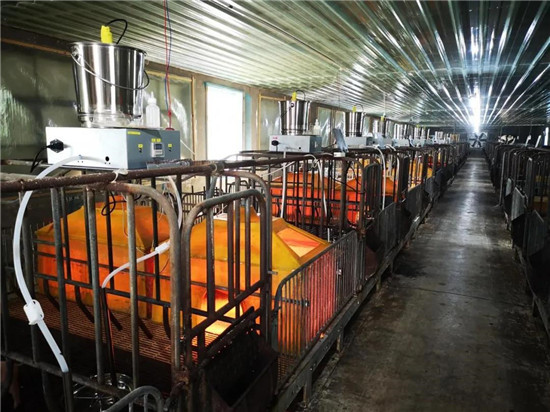Are there many stillbirths in first-born sows? It can be checked from 10 aspects.
The fetus is too large and the birth canal is relatively narrow.
Relatively more fresh stillbirths are produced by reserve sows. Because reserve sows are still in development, the birth canal is relatively narrow for the first time, and it is very easy to cause stillbirth due to dystocia and long labor process, which is easy to occur in production:
1. The sow attacks the fetus too early.
The latest data and practice have proved that early pregnancy of sows can easily lead to breast dysplasia of sows, fat sows, oversized piglets and difficult to increase postpartum feed intake of sows, which should be fed 90 days after pregnancy.
2. the reserve sows are fed the same as the parturient sows and attack the fetus in the later stage of pregnancy.
When the initial birth weight of piglets is 1.4-1.6kg, the growth rate of piglets in the later stage is faster than that of pigs with too little birth weight.
The birth weight of post-parturient sows can reach 1. 4-1.5kg, and the birth weight of reserve sows is about 1. 2-1.3kg. If the birth weight of piglets born by reserve sows reaches 1. 4-1.5kg, the possibility of spontaneous delivery is very low, and it is easy to give birth in dystocia and stillbirth.
3. All parturient sows use the same amount of feed when attacking the fetus.
When the sow attacks the fetus in the last 20 days of pregnancy, it is necessary to observe the belly size and backfat of the sow, and predict the litter size and backfat of the sow. When the belly is small and the litter size is moderate, we can not attack the fetus excessively or not, otherwise it is very easy to cause dystocia and stillbirth.
Second, sow constipation
Sow constipation is the first important signal of sow physical condition to us, but most of our pig farms do not pay attention to, or even do not care about, it should be noted that sow constipation has a great impact on production performance.
1. Anatomical and physiological structure of sows.
The top is the rectum, the middle is the birth canal, and the bottom is the bladder. When sows are constipated, the hard dung balls in the rectum directly oppress the birth canal, resulting in poor uterine blood flow, uneven muscle nutrition and deterioration of the uterine environment, resulting in poor birth uniformity of piglets and even stillbirth.
2. Constipation in sows
If the sow has constipation, which leads to the gradual accumulation of feces in the intestine, causing the toxins in the feces to be absorbed by the intestines, which will lead to the failure of the detoxification function of the liver and the detoxification function of the kidney, and then lead to a decline in cardiopulmonary function. while sows need a lot of physical strength, when the heart and lung function is poor, it will reduce the supply of oxygen to the uterine muscles, thus increasing the probability of dystocia, resulting in an increase in the probability of stillbirth.

Third, the temperature in the delivery room is too high.
After the attack of the sow in the later stage of pregnancy, the body condition of the sow is fat, and the fetus in the belly is large, which affects one of the breathing methods of the sow, the chest-abdomen breathing method. When giving birth, the sow is very afraid of heat. If the temperature of the pigsty is too high, it may lead to clinical symptoms of dyspnea in sows. This is because sows do not have sweat glands and usually use breathing and defecation to lower their body temperature.
When the sows have dyspnea, the blood oxygen concentration decreases, the supply of uterine muscle oxygen decreases, and the uterine muscle contractility decreases, that is, dystocia occurs.
When sows breathe at high frequency and cool down, a large number of calcium ions will be excreted, and the concentration of calcium ions is closely related to the contraction intensity of uterine muscle. The concentration of calcium ions in sows must reach a certain range in order to ensure the freedom of uterine contraction.
Giving birth in a high temperature environment is a great stress for sows. At this time, the sows themselves secrete a hormone to fight stress, which is epinephrine, which causes uterine vasoconstriction, reduces oxytocin reaching the smooth muscle, deprives uterine muscles of oxygen, reduces the frequency and intensity of uterine contraction, and abnormally prolongs delivery time.
IV. Lack of reproductive nutrition and oligohydramnios
Most pig farms use antibiotics for health care regularly and feed with mildew remover for a long time. Because mildew remover not only absorbs mycotoxin, but also absorbs some nutrients, resulting in lack of reproductive nutrition, resulting in poor development of piglets, oligohydramnios, low birth canal lubrication, increased resistance such as birth canal friction, dystocia.
5. Long-term limit
Due to the use of the limit bar, the sows are seriously lack of exercise, and the physical strength, endurance and muscle contractility of the sows are greatly reduced. The process of labor of sows is often too long, and it is common in clinic that the stage of labor is more than 5 hours. About 6 sows give birth to uterine contraction symptoms, and even some sows give birth to two piglets two days later, most of these two piglets are fresh stillborn. Individual sows will give birth to live births after two days, especially in elderly sows.
Use oxytocin to assist delivery
Oxytocin can stimulate uterine smooth muscle and cause uterine contraction to promote delivery. Therefore, most of our pig farms use oxytocin for midwifery. In fact, when piglets reach the pelvic mouth and squeeze the birth canal, the hypothalamus secretes oxytocin, which contracts the uterine smooth muscle, pushes the fetus into the birth canal, and the sow automatically produces driving force, which stimulates the hypothalamus to release oxytocin again and again. Each of the released oxytocin is a low dose, which is very safe, which effectively stimulates the contraction of uterine smooth muscle, and other piglets are also produced one after another. at the same time, we can give breast massage to sows and breast-feed postnatal piglets. their sucking and massage can also stimulate the release of oxytocin, so we don't need oxytocin at all.
7. Change the group
When the sow is transferred from the pregnancy house to the delivery house, due to the conditions of the barn (such as the ground is slippery and the connection between the birth bed and the ground is too high) and the impatience of the staff, it is easy to treat the sow roughly and cause the sow to fall, resulting in fresh stillbirth.
8. Feeding
Clean the unclean leftover material in the trough after each feeding, because the long-term surplus of the trough, especially the late pregnant sows, will not eat too clean, so it will lead to feed mildew and mycotoxin will lead to fetal edema and death in the uterus.
IX. Drugs
Abuse of antibiotic treatment or health care, resulting in liver and kidney damage, liver detoxification function decreased, kidney detoxification function decreased, more toxins accumulated in the body, absorbed through the birth canal detoxification resulting in birth canal edema and poor vitality or death of piglets.
10. Diseases
Reproductive disorders such as blue ear, ring, pseudorabies, Japanese encephalitis and chlamydia may cause fetal death in the womb, which are generally distinguished according to the return rate of sows, the abortion rate, the morbidity and mortality of piglets in delivery room. (source: home of Pig Friends)
- Prev

The temperature difference between cold and hot in autumn and winter is large, and the multiple occurrence of pig lung disease needs timely prevention and control
The temperature difference between cold and hot in autumn and winter is large, and the multiple occurrence of pig lung disease needs timely prevention and control
- Next

Ten risk factors for prevention and control of colibacillosis in delivery room
Ten risk factors for prevention and control of colibacillosis in delivery room
Related
- On the eggshell is a badge full of pride. British Poultry Egg Market and Consumer observation
- British study: 72% of Britons are willing to buy native eggs raised by insects
- Guidelines for friendly egg production revised the increase of space in chicken sheds can not be forced to change feathers and lay eggs.
- Risk of delay in customs clearance Australia suspends lobster exports to China
- Pig semen-the Vector of virus Transmission (4)
- Pig semen-the Vector of virus Transmission (3)
- Five common causes of difficult control of classical swine fever in clinic and their countermeasures
- Foot-and-mouth disease is the most effective way to prevent it!
- PED is the number one killer of piglets and has to be guarded against in autumn and winter.
- What is "yellow fat pig"? Have you ever heard the pig collector talk about "yellow fat pig"?

